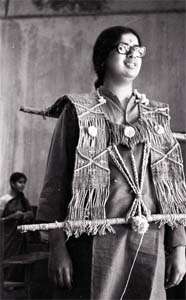Mrinalini Mukherjee
Mrinalini Mukherjee (1949–15 February 2015) was an Indian sculptor. Known for her distinctly contemporary style and use of dyed and woven hemp fibre, an unconventional material for sculpting, she had a career spawning over four decades from the 1970s to the 2000s. Mukherjee's body of work is a part of public collections at, among others, the Museum of Modern Art, Oxford, the National Gallery of Modern Art, New Delhi, and the Stedelijk Museum, Amsterdam.
Mrinalini Mukherjee | |
|---|---|
 Mukherjee with her fiber creations during the preparation for the Fine Arts Fair, 1969 | |
| Born | Mrinalini Mukherjee 1949 Bombay, India |
| Died | 15 February 2015 New Delhi, India |
| Nationality | Indian |
| Alma mater | Welham Girls' School Maharaja Sayajirao University, Vadodara West Surrey College of Art and Design |
| Known for | Sculpture |
Early Life and Education
Mukherjee was born in 1949, in Bombay, India to artists Benode Behari Mukherjee and Leela Mukherjee.[1] The only child to her parents, she was brought up in the North-Indian hill town of Dehradun, where she attended Welham Girls' School, and spent her summer vacations in Santiniketan.[2]
Mukherjee went to study Bachelor of Fine Arts (Painting) at Maharaja Sayajirao University of Baroda.[3][4] Thereafter, she did a Post Diploma in Mural Design form the same university under the Indian artist K.G. Subramanyan who was also a member of the Fine Arts Faculty at the university. Her studies included working Italian Fresco and other conventional techniques. She worked with natural fibers as a medium for mural.[5]
Career
Mukherjee's first solo exhibition was held at Sridharani Art Gallery in New Delhi in 1972. It featured warped, woven forms in dyed natural fibers—a series of works that brought her recognition. She named her sculptures after deities of fertility and were seen as sensual and suggestive.[6] Mukherjee received a British Council Scholarship for Sculpture in 1971 that sent her to the West Surrey College of Art and Design, where she pursued her tied-fiber works till 1978.[6]
While most of Mukherjee's early work was characterized by the use natural hemp fiber, she also ventured into working extensively with ceramic and bronze later in her career.[6][7]
Mukherjee was invited to the Museum of Modern Art, Oxford to hold an exhibition conducted by David Elliott in 1994. The same exhibition further traveled to other cities in the United Kingdom over the course of the next few months. Mukherjee later participated in an international workshop that was held Netherlands in 1996.[8]
In 2019, the Metropolitan Museum of Art hosted a posthumous retrospective of Mukherjee's oeuvre titled "Phenomenal Nature: Mrinalini Mukherjee." In her review of the exhibition, art critic Nageen Shaikh observes: "Perhaps the principal lesson that historians, critics, and viewers acquire with an astounding retrospective like Mukherjee’s is how art can resist being viewed as delineated under a methodical Western canon. Her massive oeuvre is not fully representational, neither completely abstract. It learns from her native history and tradition, while educating us in new ways to engage with subtleties of her work."[9]
Technique and style
Mukherjee was influenced by traditional Indian and historic European sculpture, folk art, modern design, local crafts and textiles.[10] Knotting was one of her main techniques; she worked intuitively and never worked based on sketches, models or preparatory drawings.[11]
The authors of Indian Contemporary Art Post-Independence dubbed Mukherjee as a "unique voice in contemporary Indian art", and remarked "The sculptures knotted painstakingly with hemp ropes in earthy or rich glowing colours evoke a fecund world of burgeoning life, lush vegetation, iconic figures." Acknowledging the note of sexuality manifested in the "phallic forms", they added "the mysterious folds and orifices, the intricate curves and drapes. There is a sensuous, tactile quality to her work which exercises a compelling hold on the viewer."[12]
Mukherjee studied under K. G. Subramanyan, and derived heavily from his artistry. Sonal Khullar writing on Subramanyan's influence on her wrote in Worldly Affliations Mukherjee a former student, "[...] use jute, wood, rope, and cow dung to create environments at once magical and mundane. Their inventiveness with visual language and investments in ordinary materials are a legacy of Subramanyan's teaching, writing and art-making."[13]
Art historian and independent curator Deepak Ananth also ascribed Mukherjee's predilection for modest, earthly materials to her influence from Subramanyan, and in turn from the history of Indian artisanal craft. In an essay entitled "The Knots are Many But the Thread is One", Ananth wrote, "As if in harmony with the vegetable realm from which her medium is derived, the leading metaphor of Mukherjee's work comes from the organic life of plants. Improvising upon a motif or image that serves as her starting point the work's gradual unfolding itself becomes analogous to the stirring into maturation of a sapling."[8]
Influences
In the context of the pedagogy professed by K G Subramanyan, Mukherjee's decision to work in a material traditionally associated with her craft rather than "high art" reflects her teacher's conscious attempts to overcome what they considered to be a staple polarity in Modernism, not least in view of the extreme richness and continuing actuality of traditional artisanal skills in India and the sheer versatility of popular vernacular idioms.[14]
Death
Mukherjee died at the age of 65, after a brief illness.[15]
Public collections
- Museum of Modern Art, Oxford
- Yorkshire Sculpture Park, Yorkshire
- Stedelijk Museum, Amsterdam
- National Gallery of Modern Art, New Delhi
- Lalit Kala Akademi, New Delhi
- Roopankar Museum of Art, Bharat Bhawan, Bhopal
- Fine Arts Museum, Panjab University, Chandigarh
- India Tourism Development Corporation, New Delhi
- India Institute of Immunology, New Delhi
- Tate Modern, London[16]
- Government Museum and Art Gallery, Chandigarh[17]
See also



References
- Dalmia, and Datta, and Sambrini, and Jakimowicz, and Datta (1997) Indian Contemporary Art Post-Independence. p.206
- "Education". Nature Morte.
- Gupta, Trisha (23 May 2015). "Secular Deities, Enchanted Plants: Mrinalini Mukherjee at the NGMA". The Wire. Retrieved 25 June 2019.
- Ghoshal, Somak (8 November 2013). "Mrinalini Mukherjee – Nature as art". Live Mint. Retrieved 26 June 2019.
- Mrinalini Mukherjee, RECENT SCULPTURE IN CERAMICS , ‘In the Garden’. Defence Colony, New Delhi: Vadhera Art Gallery. 1997.
- "ArtAsiaPacific: Indian Sculptor Mrinalini Mukherjee Dies At65". artasiapacific.com. Retrieved 4 February 2019.
- "Mistress of texture". The Indian Express. 10 February 2015. Retrieved 16 September 2017.
- Bent, Siobhan (5 February 2016). "Indian Sculptor Mrinalini Mukherjee Dies at 65". ArtAsiaPacific. Retrieved 9 April 2017.
- Shaikh, Nageen (2019). ""Exploring Sexuality and Myth Through Fiber and Other Types of Sculpture"". Hyperallergic. Retrieved 9 May 2020.
- Jhaveri, Shanay (2019a). "Phenomenal Forces of Nature". In Jhaveri (2019), p. 12.
- Jhaveri (2019).
- Dalmia, and Datta, and Sambrini, and Jakimowicz, and Datta (1997) Indian Contemporary Art Post-Independence
- Khullar (2015) Worldly Affiliations: Artistic Practice, National Identity, and Modernism in India, 1930–1990. p.134
- Lalit Kala Contemporary 43. Delhi: Lalit Kala Akademi. 200.
- Bent, Siobhan (5 February 2015). "Indian Sculptor Mrinalini Mukherjee Dies at 65". ArtAsiaPacific Magazine. Retrieved 22 August 2019.
- "Mrinalini Mukherjee – Display at Tate Modern". Tate Etc. Retrieved 26 June 2019.
- "Government Museum and Art Gallery Chandigarh". Archived from the original on 23 May 2017. Retrieved 9 April 2017.
Bibliography
- Dalmia, Yashodharea and Datta, Ella and Sambrini, Chaitnya and Jakimowicz, Martha and Datta, Santo (1997). Indian Contemporary Art Post-Independence (English). New Delhi: Ajanta Offset Ltd.
- Jhaveri, Shanay, ed. (2019). Mrinalini Mukherjee. Mumbai: Shoestring. ISBN 9788190472098.CS1 maint: ref=harv (link)
- Khullar, Sonal (2015). Worldly Affiliations: Artistic Practice, National Identity, and Modernism in India, 1930-1990. California: University of California Press.
Further reading
- Ananth, Deepak, et. al.. Mrinalini Mukherjee. New York: The Shoestring Publisher, 2019.
- Cotter, Holland (11 July 2019). "Sculpture, Both Botanical and Bestial, Awe at the Met Breuer". The New York Times.
- Gardner, Andrew (11 December 2019). "Mrinalini Mukherjee: Textile to Sculpture". Post. New York: Museum of Modern Art.